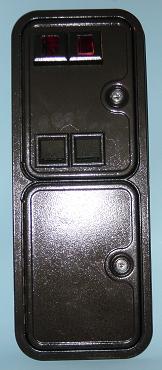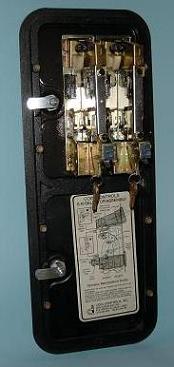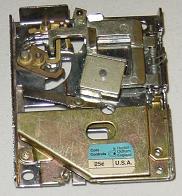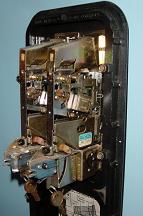Difference between revisions of "Coin Doors"
| Line 1: | Line 1: | ||
| − | + | [[Image:coin door frt sm.jpg|thumb]][[Image:coin door bk sm.jpg|thumb]] | |
| − | [[Image:coin door frt sm.jpg]][[Image:coin door bk sm.jpg]] | ||
| − | |||
A '''coin door''' can be added to your arcade cabinet purely as a decoration, or for functionality. | A '''coin door''' can be added to your arcade cabinet purely as a decoration, or for functionality. | ||
| − | It is | + | It is possible to wire up a coin door with switches and interface them to a keyboard encoder. The encoder sends a signal that corresponds to the "credit" command. This allows a coin to act as it would in a real machine. Most coin doors have the same type of switch as a normal arcade button which makes it simple to wire it up to your encoder. |
You can also wire up the lights on your coin door by taking 5V or 12V power from your PC and running it to the light bulbs on the door. Additionally, many people modify coin doors to use LEDs instead of incandescent bulbs. The reason for this is the available colors and longevity. LEDs will last a hundred times longer than incandescent bulbs. Many people utilize 5V or 12V LEDs with resistors and connect the LEDs bulbs to the PC Molex Connector. Ensure the voltage on the positive side of the Molex connector matches the voltage of your LED or incandescent bulb. | You can also wire up the lights on your coin door by taking 5V or 12V power from your PC and running it to the light bulbs on the door. Additionally, many people modify coin doors to use LEDs instead of incandescent bulbs. The reason for this is the available colors and longevity. LEDs will last a hundred times longer than incandescent bulbs. Many people utilize 5V or 12V LEDs with resistors and connect the LEDs bulbs to the PC Molex Connector. Ensure the voltage on the positive side of the Molex connector matches the voltage of your LED or incandescent bulb. | ||
| − | ==Coin Mechanisms== | + | == Coin Mechanisms == |
| − | [[Image:coinmechsm.jpg]][[Image:coinmechinstalledsm.jpg]] | + | [[Image:coinmechsm.jpg|thumb]][[Image:coinmechinstalledsm.jpg|thumb]] |
| − | |||
Often called "Coin Mechs" or "Coin Acceptors", a coin mechanism is a mechanical or electrical device that discriminates between different types of coins and routes them to the accept chute, or the reject chute, as appropriate. | Often called "Coin Mechs" or "Coin Acceptors", a coin mechanism is a mechanical or electrical device that discriminates between different types of coins and routes them to the accept chute, or the reject chute, as appropriate. | ||
Mechanical coin mechanisms use carefully machined parts to check diameter, thickness, and weight of the coin. A strong magnet also provides some protection against use of "slugs". A rejected coin is usually trapped at some point during the checking, requiring the user to press the "reject button" in order to allow the coin to drop out the reject chute. | Mechanical coin mechanisms use carefully machined parts to check diameter, thickness, and weight of the coin. A strong magnet also provides some protection against use of "slugs". A rejected coin is usually trapped at some point during the checking, requiring the user to press the "reject button" in order to allow the coin to drop out the reject chute. | ||
| − | ==Coin Counters== | + | == Coin Counters == |
| − | Coin Counters can be easily wired between a single coin acceptor. Simply wire Ground on your [[Pushbuttons#Microswitch_Pushbuttons | microswitch]] to the 5V line on your counter. Then wire the Ground on your Counter to your [[Encoders | encoder]] ground. | + | Coin Counters can be easily wired between a single coin acceptor. Simply wire Ground on your [[Pushbuttons#Microswitch_Pushbuttons|microswitch]] to the 5V line on your counter. Then wire the Ground on your Counter to your [[Encoders|encoder]] ground. |
| − | Alternatively to wire up '''all''' your coin acceptors/buttons you'll need to put diodes between your [[Encoders | encoder]] and each [[Pushbuttons#Microswitch_Pushbuttons | microswitch]]. | + | Alternatively to wire up '''all''' your coin acceptors/buttons you'll need to put diodes between your [[Encoders|encoder]] and each [[Pushbuttons#Microswitch_Pushbuttons|microswitch]]. |
| − | ==See Also== | + | == See Also == |
* [[Basics]] | * [[Basics]] | ||
* [[Finishing]] | * [[Finishing]] | ||
| + | |||
| + | == External Links == | ||
| + | * [http://www.retroblast.com/articles/coindoor.html http://www.retroblast.com/articles/coindoor.html] | ||
| + | |||
[[Category:Basics]] | [[Category:Basics]] | ||
[[Category:Index]] | [[Category:Index]] | ||
[[Category:Finishing]] | [[Category:Finishing]] | ||
| − | |||
| − | |||
| − | |||
| − | |||
Revision as of 21:10, 16 October 2007
A coin door can be added to your arcade cabinet purely as a decoration, or for functionality.
It is possible to wire up a coin door with switches and interface them to a keyboard encoder. The encoder sends a signal that corresponds to the "credit" command. This allows a coin to act as it would in a real machine. Most coin doors have the same type of switch as a normal arcade button which makes it simple to wire it up to your encoder.
You can also wire up the lights on your coin door by taking 5V or 12V power from your PC and running it to the light bulbs on the door. Additionally, many people modify coin doors to use LEDs instead of incandescent bulbs. The reason for this is the available colors and longevity. LEDs will last a hundred times longer than incandescent bulbs. Many people utilize 5V or 12V LEDs with resistors and connect the LEDs bulbs to the PC Molex Connector. Ensure the voltage on the positive side of the Molex connector matches the voltage of your LED or incandescent bulb.
Coin Mechanisms
Often called "Coin Mechs" or "Coin Acceptors", a coin mechanism is a mechanical or electrical device that discriminates between different types of coins and routes them to the accept chute, or the reject chute, as appropriate. Mechanical coin mechanisms use carefully machined parts to check diameter, thickness, and weight of the coin. A strong magnet also provides some protection against use of "slugs". A rejected coin is usually trapped at some point during the checking, requiring the user to press the "reject button" in order to allow the coin to drop out the reject chute.
Coin Counters
Coin Counters can be easily wired between a single coin acceptor. Simply wire Ground on your microswitch to the 5V line on your counter. Then wire the Ground on your Counter to your encoder ground.
Alternatively to wire up all your coin acceptors/buttons you'll need to put diodes between your encoder and each microswitch.



